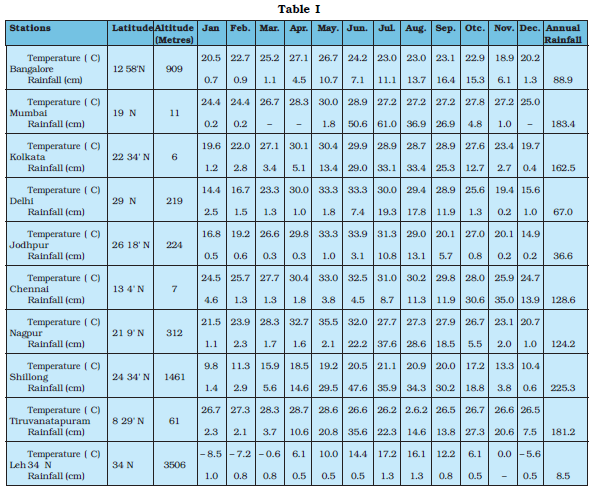Now think why

(i) Think why Thiruvananthapuram has equable climate?
(ii) Chennai has more rains only after the fury of monsoon is over in most parts of the country?
(iii) Jodhpur has a hot desert type of climate?
(iv) Leh has moderate precipitation almost throughout the year.
(v) While in Delhi and Jodhpur most of the rain is confined to nearly three months, in Thiruvananthapuram and Shillong it is almost nine months of the year?
In spite of these facts see carefully if there are strong evidences to conclude that the monsoons still provide a very strong framework lending overall climatic unity to the whole country.
(i) Equable climate generally is experienced in all stations falling nearer to the sea as the moisture does not allow high pressure to be formed any time here. This fact, also applies on Thiruvananthapuram and we see here equable climate throughout the year.
(ii) South-West Monsoon Winds start retreating in September to October months. These are replaced by the North-East trade winds, i.e., winds blowing from extreme northwest of India. These winds receive vapor while moving over the Bay of Bengal to which they immediately carry to the Coromandal Coast in Tamil Nadu. These rain-bearing winds collide against Eastern Ghats and thus, Coromandal including Chennai receives heavy rain during winter season (viz. in November-December).
(iii) Jodhpur falls in the rain shadow region and it is situated proxy to the Thar desert. This station has therefore, extreme climate and dusty as also hot winds namely "Loo" starts blowing here during summer. As the water-bearing winds pass over it without raining, this station remains arid throughout the year.
(iv) North-east trade Winds blow throughout the year in Leh district of Jammu and Kashmir state. Monsoon winds never reach up to this altitude as they get lost their water completely. This station receives mostly snowfall because of its super altitude. Being it the coldest place, water-drops are frozen here. Thus, no rainfall or scanty precipitation we can only see here.
(v) Monsoon winds always prefer to blow over Thiruvananthapuram and Shillong irrespective of their distance from the sea. The winds blowing from Indian Ocean, Bay of Bengal and that of Arabian Sea simultaneously cover these stations during rainy season. Disturbances are caused over Andaman Sea and the Bay of Bengal as a result of the North-East trade winds
Usually fill the void created by the retreating monsoon during winter season. These winds while passing over above said sea; generally get vapor and do heavy rain in Shillong and Thiruvananthapuram. Thiruvananthapuram falls adjacent to the Arabian sea and Indian Ocean and Shillong is also nearer to Bay of Bengal and Andaman Sea. Delhi and Jodhpur are at larger distance from the sea coupled with nearer to the terrestrial region as also falling sub-tropical belt. Hence, both these stations receive heavy rain during three months while these remain dry during the next nine months of the year. We can state in brief that quantum of rain here is affected due to different landforms, temperature, distance from the sea and mean altitude from the sea level.